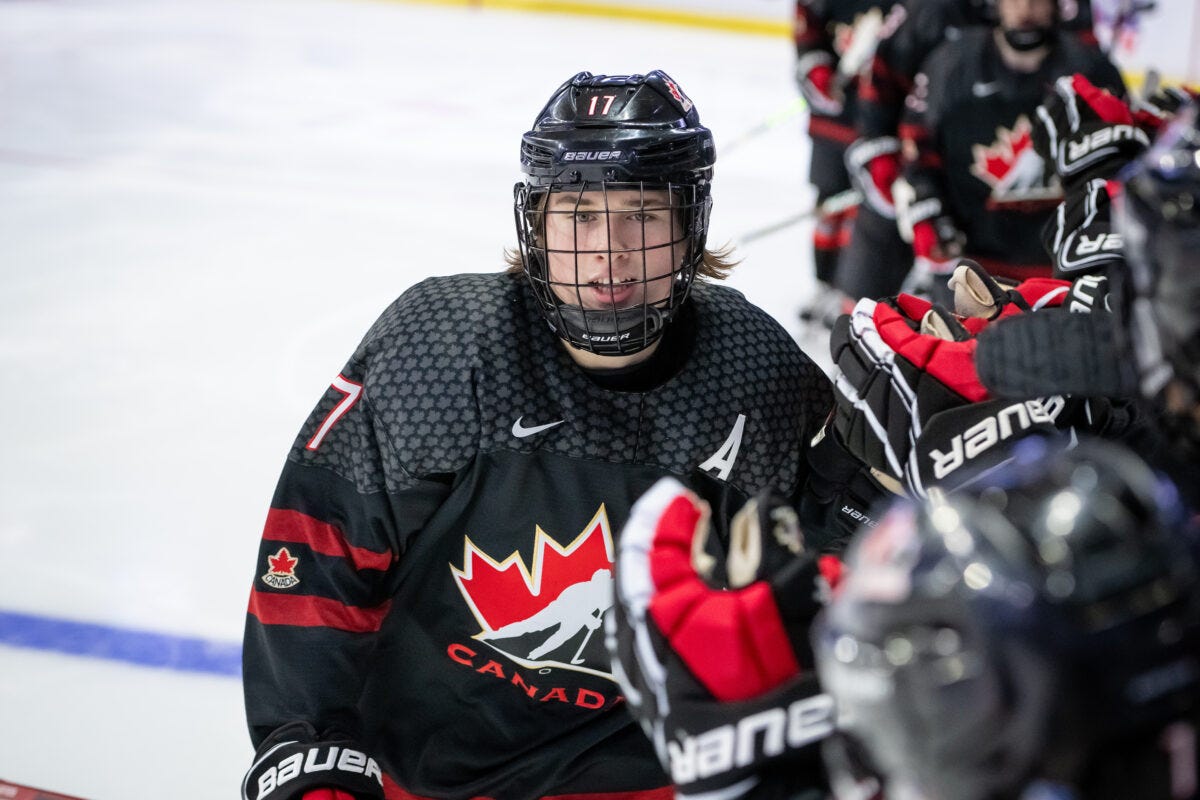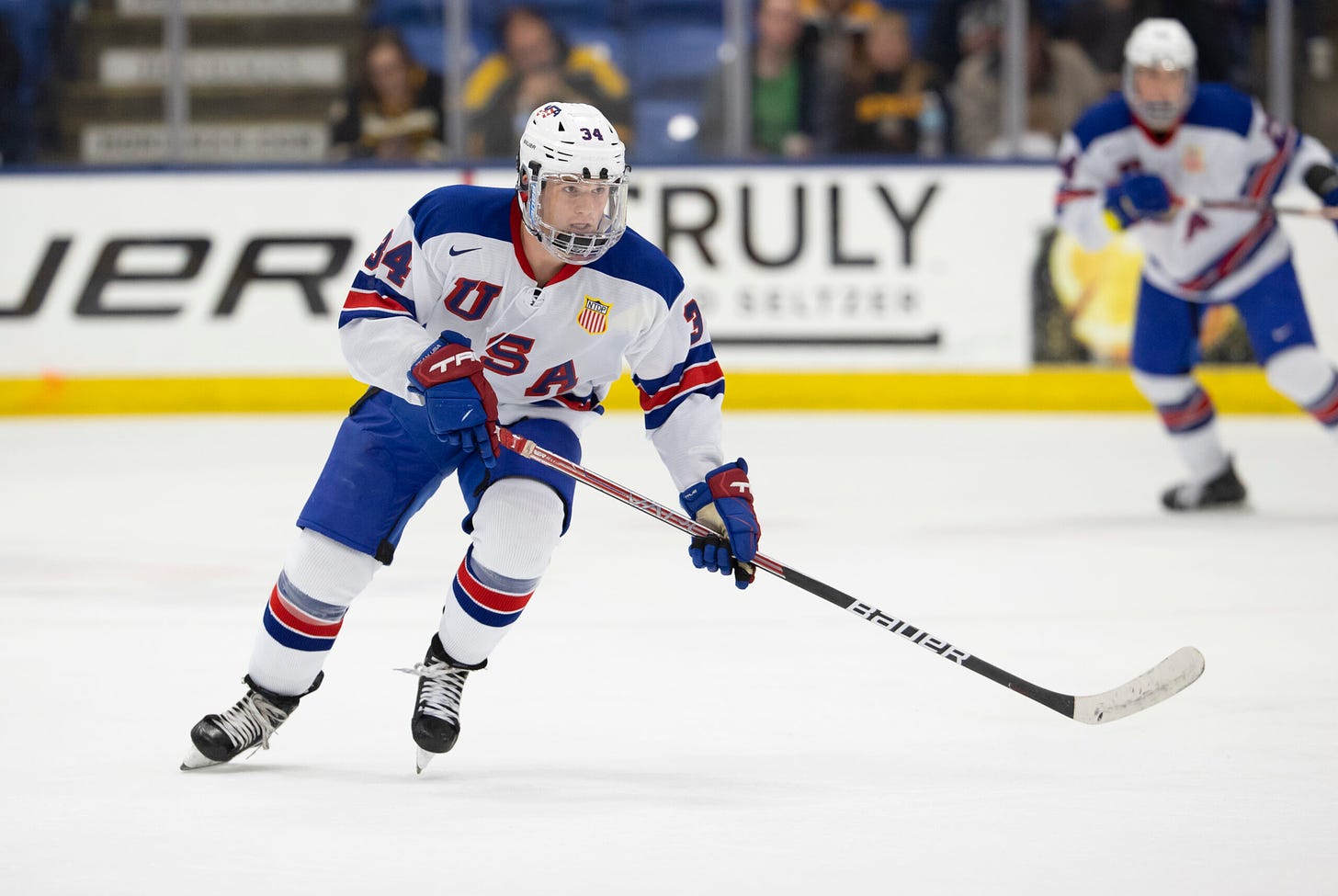Reacting to the NHL's Midterm Rankings
The NHL's Central Scouting Service put out their midterm ranking, and there were some interesting choices made.
When the NHL’s Central Scouting Bureau releases its midterm list, it signifies the official start of draft season. It’s the list that every other ranking reference, as it’s the definitive list of every eligible prospect to the majority of the public. To be mentioned on the midterm list, even down at 224th, is a big honour among players and a recognition that they are worth paying attention to.
However, it’s far from perfect, and given its status among scouts and fans, people have plenty to say about it when the rankings don’t line up with the consensus. This year was no different, with several prospects appearing in surprising spots on the NHL’s list. So, after going through the names at the top, here are a few things that jumped out at me.
Who’s On Top?
It’s no surprise that Macklin Celebrini sits at the top of the North American skaters. His performance at the World Junior Championship firmly established that he’s one of the most talented prospects in the world, let alone eligible for the 2024 Draft. In five games, he led a struggling Team Canada with four goals and eight points and was frequently the only player who looked dominant on the ice. Sure, he’s no Connor Bedard and won’t be able to change a franchise’s direction single-handedly, but his World Juniors showing has me wondering if he’s even better than advertised.

However, it’s somewhat surprising that Konsta Helenius topped the International skaters list. It’s not that he’s not talented; his 20 points in 29 games leads all U18 players in the Liiga by a wide margin - second place is fellow first-round hopeful Emil Hemming, who has just eight points - and is the second-highest-scorer among all teenagers in Finland’s top league this season.
But Helenius’ World Junior performance wasn’t spectacular. Finland didn’t have a lot of center depth, giving him a great opportunity to climb up the lineup. Yet in the end, he finished with just one goal and two points in seven games. The only reason I can see for his jump to first is that he was actually at the tournament and looked competent most nights. His biggest competitors didn’t get that opportunity, and when it comes to draft rankings, exposure is incredibly important.
Surprising Changes Among the Runners-Up
Ivan Demidov has generally been regarded as the second or third-best prospect heading into the 2024 Draft. After missing two months with a knee injury to start the season, his point-per-game pace is the highest among any player in Russia’s junior league, the MHL, who has appeared in at least five games. Some have even posited that he’s a better prospect than Matvei Michkov, who was briefly in the running for first overall last year before Bedard ran away with it.
Yet Demidov has fallen to third among International skaters and it seems that his lack of participation at the World Juniors was a big factor. Russia, of course, can’t compete at the tournament after they were banned in 2022, but not having him there removed him from the public eye. The MHL is not an easy league to scout as the competition can vary widely, and since he hasn’t played many KHL games yet, his rank took a hit.
Fellow Russian Anton Silayev, who is ranked second, faced a similar fate to Demidov. However, he probably snuck ahead of Demidov thanks to his full season in the KHL. He currently has 48 games played with Torpedo Nizhny Novgorod and has put up three goals and 11 points, tying him for first among U20 defencemen - not too shabby for a 17-year-old in Russia’s best league. It also doesn’t hurt that he stands 6-foot-7, towering a full eight inches over Demidov.
But maybe the most surprising is Cole Eiserman, who dropped from a potential runner-up to Celebrini to eight on the North American skaters. Back in November, he was on pace to break Cole Caufield’s United States National Development Program (USNDP) single-season goal-scoring record of 72 goals in 64 games. That no longer seems to be the case, but with 32 goals in 30 games, he’s almost double the second-highest scorer on the team. So why did he drop so far?
Once again, it comes down to exposure. Eiserman wasn’t even considered for the United States’ World Junior team and was left off the preliminary roster, while 2025 top prospect James Hagens was included. Even though Eiserman has continued to score wherever he’s gone - he has 14 goals in 12 United States Hockey League (USHL) games - it wasn’t enough to put him ahead of some other prospects who were given bigger opportunities.
Big Defencemen Took Over the Top 10
There’s been a heavy focus on the dynamic forwards at the top of the draft like Celebrini, Demidov, and Eiserman. But, after them, big defencemen will be the most highly sought-after players, and there are a lot of them.
Coming second on the North American list is Artyom Levshunov, a 6-foot-2 Belorussian playing with Michigan State University. He has 20 points in 21 games, demonstrating an already impressive offensive total from a freshman blueliner, but he’s also the third-youngest player in the NCAA. Oh yeah, he’s also a right shot. While second place might be a bit high, it stands to reason why he was put there.
Then there’s World Junior gold-medalist Zeev Buium, who had three goals and five points, while no other American defenceman had more than one. He sits fourth among North Americans, which also feels deserved; he’s been steadily climbing the charts, and his World Junior showing was just more icing on the cake for an awe-inspiring season so far.
But the next best defenceman, coming in at sixth among North Americans, was Carter Yakemchuk. I’ve watched him play live, and I have to admit, I wasn’t overly impressed with him. He’s got great puck skills, sure, but his defensive game is lacking and, on a weaker Calgary Hitmen team, he wasn’t much of an impact. Yet he sits ahead of London Knights’ blueliner Sam Dickinson, who ranks seventh and is a much more well-rounded player. Given that both are 6-foot-3 and are over a point per game, I would have reversed the order, but it seems that being a right-shot defender won the day this time.
That’s when I started to notice a pattern - none of these defencemen are under 6-foot-0. Five defencemen are listed in the top 10, nine in the top 32 on the North American list, and the shortest are Buium, Zayne Parekh, and Henry Mews, all of whom stand 6-foot-0. You have to scroll down to 57th before finding the first sub-six-foot defender, Cole Hutson, who stands 5-foot-10. The younger brother of Lane Hutson doesn’t have the same offensive touch as his sibling, but he still leads the USNDP’s defence with 27 points in 34 games. His teammate, EJ Emery, ranks 39th but has nine points in 34 games. The big difference? He’s 6-foot-3.
Size was less of an issue on the International list but still affected it. After Silayev, 5-foot-9 Aron Kiviharju made the top 10 and 5-foot-11 Leo Sahlin Wallenius fell just outside at 11th. But then there’s 6-foot-3 Matvei Shuravin, who has 13 points in 37 MHL games and was ranked eighth, while Sahlin Wallenius is nearly a point per game in Sweden’s U20 junior league. Size has always been a concern on the blue line, so I expected some bias, but to see it play out so egregiously was surprising.
Don’t miss our latest Prospect Corner Show on The Hockey Writers YouTube Channel
Final Observations
After getting over the big names, a few other things jumped out to me. First of all, only one player from the Quebec Major Junior Hockey League (QMJHL) was listed among the top 32 North American prospects, Maxim Masse at 23rd. Raoul Boilard just missed the cut-off, coming in at 34th.
There was also only one high-school prospect listed among the top 32, which was more surprising that he was there at all. But Dean Letourneau, who came in at 20th, has 39 goals and 76 points in 33 games with St. Andrew’s College. He’s also 6-foot-6, which probably helped his cause. He’s now playing in the USHL with the Sioux Falls Stampede, so it will be interesting to see if he can keep up his incredible pace.
As for goalies, it appears to be a weaker crop this year. The top-ranked North American goalie was the Owen Sound Attack’s Carter George, and over on the International list, Finn Kim Saarinen came in first. Neither is expected to go in the first two rounds, although I wonder if Eemil Vinni, ranked second among Europeans, could push for the top spot.
What stuck out to you from Central Scouting’s midterm ranking? Should Cole Eiserman be ranked higher? Leave your comments and questions below for a future mailbag!



